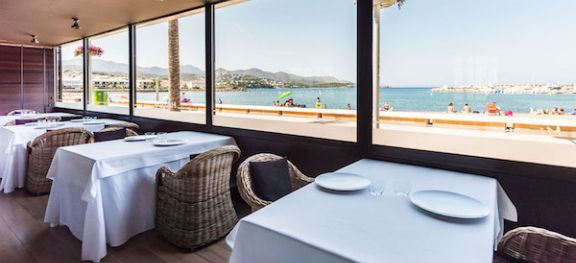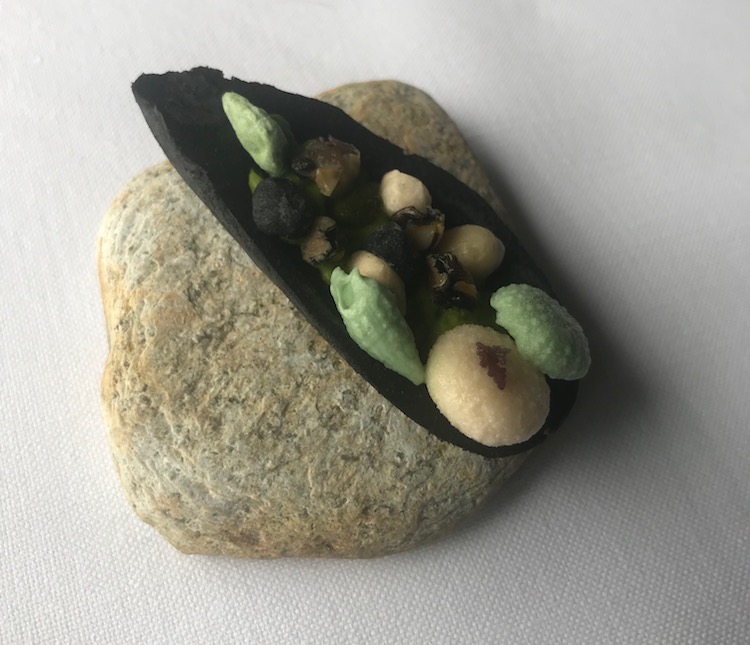A culinary gem in Spain's far north east

A version of this article is published by the Financial Times.
My ideal restaurant table is table 32, or any of the four tables along the window of the Miramar restaurant in the Catalan resort of Llançà, just up the coast from its better-known neighbour Cadaqués.
This restaurant is no more than 20 metres from the sea, separated by a path along which passers-by stroll as though they were in more fashionable San Sebastian. In the distance are the Albères mountains, the foothills of the Pyrenees. At one end is the harbour where the fishing boats and the more expensive yachts are moored.
Through another large glass window at the back of the restaurant is the kitchen. Here it is possible to follow the tranquil workings of the young chefs, immaculately turned out in their spotless white uniforms.
A great deal has changed since Montse Serra’s grandparents decided to settle here, rather than over the border in France, in 1939. But the sea and the mountains, and their collective bounty, have not.
This was what attracted the young chef Paco Pérez, who had trained under Michel Guérard at Eugénie-les-Bains in South West France, to this village in the 1990s. Love brought Pérez and Serra together and they are together today at the helm of an unusually luxurious restaurant to which they have now added five smart bedrooms.
Over this period, the couple have fashioned a restaurant that not only reflects its location but also its time. And with it they have created a wine list and a style of service that are the equal of the creative food their kitchen produces.

The wine list is probably unique. Created each year by Toni Gata, Miramar’s sommelier, in January and February when the restaurant is closed, it is a thick hardback book complete with colour photographs with its vintage stamped on the spine. It is as comprehensive as it is beautiful, from vintages of Château Lafite and Le Pin to the much less expensive local wines. Their German selection is excellent and we drank a Saar Riesling 2014 Van Volxem for €50 out of a total bill of €330.
The service team is led by Manel Espinet. A young Catalan who, despite wearing a suit and tie, exudes a relaxed sense of welcome. This is a key ingredient, because if the service were too po-faced the overall effect would be extremely off-putting. But the view of the sea from the kitchen seems to put a smile on the faces of all Espinet’s team.
The menu opens with two dishes described as ‘history’, plates of anchovies and Iberico ham, before presenting the first-time visitor with a quandary – which are the first courses and which are the mains? As in many restaurants of this calibre, price is no indication as the first courses invariably demand a similar level of ingredients and preparation time. Each here is around the €50 mark.

We in fact chose from completely different sections of the menu. Jancis chose a tartare of oysters topped with caviar and apple foam, a dish created in 2000, followed by tempered prawns with a morel stew, while I opted for hake cheeks with asparagus and a pil pil sauce (above) followed by their one rice dish with lobster, lobster roe and what was listed, intriguingly, as marine sprouts.

First of all came three assortments of amuse bouches, each of them more exciting than its predecessor. The first, served immediately we had ordered, was what looked like a piece of the palest white biscuity dough filled with pink and green dots that tasted, separately, of the sea, alongside a wooden, Japanese-inspired cup of hydromel, made from local honey, that was apparently designed to open up our taste buds.

Then came their version of a Caesar salad (above), a crisp tube of thinnest gauffre each, beautifully decorated and stuffed with herbs, which we were to enjoy after spooning out a particularly well-seasoned iced lettuce soup from an eggcup in the shape of a lettuce leaf.

There followed a trio of dishes that shared a complexity of execution: a padrón pepper that had been opened up to reveal several versions of the pepper; an edible shell in the shape of a mussel that contained miniature sorbets of sea urchin and other edible food stuffs gathered from along the sea shore (above); and finally a ball of ice that had been hollowed out to hold a ‘bolo Mary’, a cockle submerged under a heady Bloody Mary (below).

Each happily paved the way for what we had actually ordered. My hake cheeks and the lobster rice were excellent, the former highlighted by the addition of nitrogen to the smoking pil pil sauce, but it was Jancis’s two dishes that stood out. The combination of the oysters, caviar and apple foam was first class and the sweetness of the locally caught langoustines contrasted beautifully with the earthy savour and texture of the last of this season’s morels (below).

At a loss as to which dessert to choose, I somewhat reluctantly accepted Espinet’s suggestion of a dish described as ‘black forest cake’. This was quite a contrast to the somewhat heavy original and comprised a cherry ice cream made in a Japanese machine that produces flakes of ice cream which sat under cherry juice and chocolate-covered cherries. This was as impressive as the rest of the meal, after which we were treated to a tour of all the boys toys in the kitchen.

Miramar’s menu and wine list open with a quote attributed to Steve Jobs: ‘simplicity is the greatest sophistication’. The food and service at the Miramar are certainly sophisticated but far from simple.
Miramar Passeig Maritim 7, 17490 Llançà, Catalunya; +34 972 38 01 32
Become a member to view this article and thousands more!
- 15,420 featured articles
- 274,421 wine reviews
- Maps from The World Atlas of Wine, 8th edition (RRP £50)
- The Oxford Companion to Wine, 5th edition (RRP £50)
- Members’ forum
- 15,420 featured articles
- 274,421 wine reviews
- Maps from The World Atlas of Wine, 8th edition (RRP £50)
- The Oxford Companion to Wine, 5th edition (RRP £50)
- Members’ forum
- Commercial use of our Tasting Notes
